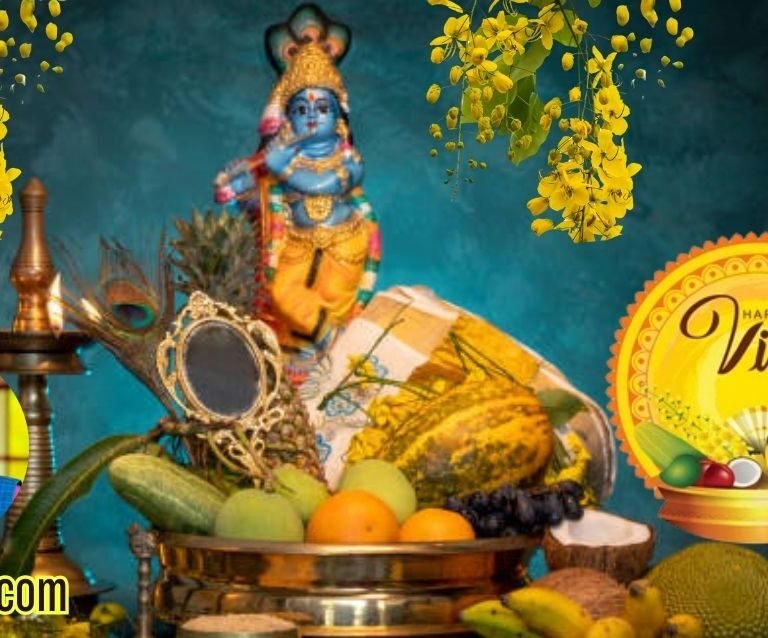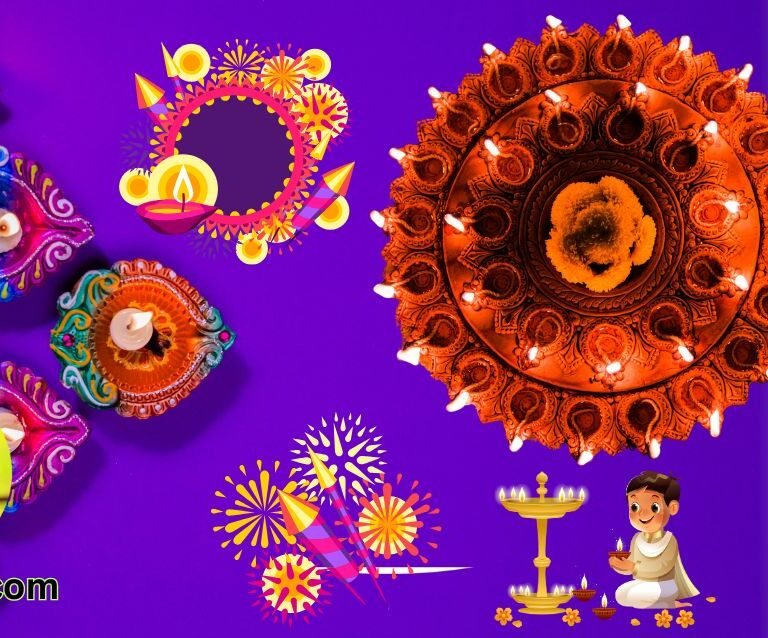Vishu
Vishu is a highly celebrated festival that marks the beginning of the new year in the state of Kerala, India. This momentous occasion typically falls on the 14th of April and is deeply rooted in the agricultural calendar, symbolizing the harvest season. The significance of Vishu lies not only in its timing but also in the rich tapestry of customs and traditions that it encompasses. It symbolizes prosperity, abundance, and the hope for a fruitful year ahead.
The celebration of Vishu serves as a spiritual and cultural awakening for the people of Kerala. On this day, families gather to witness the first sight of the auspicious “Vishukkani,” which is an arrangement that includes rice, fruits, vegetables, and other symbols of prosperity, placed before a deity or a family elder. This visual arrangement is intended to bring good fortune and is believed to shape the fortunes of the entire year. The act of seeing the Vishukkani in the early morning is considered to bring a sense of positivity and blessings.
In addition to this, the traditions associated with Vishu vary across different communities within Kerala, yet the core values of renewal and gratitude to the harvest remain consistent. People participate in the joyful celebration by wearing new clothes, preparing delicious traditional dishes such as “Payasam,” and bursting fireworks to mark the occasion. The vibrant rituals reflect the agrarian lifestyle of the region and emphasize the importance of community and connection to nature.
Vishu is not merely a festival; it is a representation of Kerala’s rich cultural heritage and serves to reinforce the bonds among families and communities. It resonates deeply within the hearts of the Keralites, making it a pivotal event on their cultural calendar. As such, understanding the essence of Vishu allows one to appreciate not only the festival itself but also the spirit and resilience of the people who celebrate it.
Historical Background of Vishu
The celebration of Vishu is deeply rooted in the history of Kerala, tracing its origins back to the reign of Sthanu Ravi in the 9th century AD. This period was marked by significant socio-political shifts that influenced the culture and traditions of the region. Sthanu Ravi, a ruler who is said to have ushered in an era of prosperity, played a crucial role in the development of agricultural practices, which had a profound impact on the local communities. Given that Vishu is traditionally celebrated as a harvest festival, its inception aligns closely with the agrarian society that flourished during this time.
As a pivotal festival in the Hindu calendar, Vishu signifies the start of the Malayalam New Year and serves as a time for families to come together in celebration. The historical context of the festival reveals how it evolved in tandem with the socio-economic circumstances surrounding agriculture, which is the lifeblood of Kerala’s economy. It bestowed a sense of hope and renewal as the farmers prepared to reap their rewards after a season of hard labor. As the agricultural practices advanced under Sthanu Ravi’s reign, so too did the customs and rituals associated with Vishu.
Throughout the centuries, the festival has incorporated various cultural elements, reflecting the diverse fabric of Kerala’s society. The influence of trade, migration, and interactions with other cultures have contributed to the evolving nature of Vishu celebrations. The rich tapestry of rituals, such as the Vishu Kani, which marks the auspicious beginning of the New Year, and the tradition of bursting firecrackers, are testament to the blending of various cultural influences over time. This evolution illustrates how Vishu is not merely a festival but a representation of the historical narrative that has shaped Kerala’s identity.
The Mythological Narrative of Vishu
The celebration of Vishu, marking the beginning of the new year in the Malayalam calendar, is deeply rooted in rich mythological narratives. Central to this festival is the legendary tale of Narakasura, a demon king whose tyranny tormented the celestial beings and common folk. The lore describes Narakasura as a powerful, malevolent figure who acquired immense strength through penance, ultimately leading him to terrorize both the heavens and the earth. This widespread suffering prompted the divine intervention of Lord Krishna, the eighth incarnation of Vishnu.
The narrative unfolds with Krishna, who embodies virtue and justice, confronting Narakasura. Engaged in an epic battle, Krishna ultimately prevails, vanquishing the demon king. This victory symbolizes the triumph of good over evil and is instrumental in the festivities associated with Vishu. As a result of his defeat, Narakasura granted his mother, Earth, the right to celebrate the day of his downfall as a New Year festival, thus ingraining the essence of hope and renewal in the heart of Vishu.
Moreover, the festival of Vishu is not solely defined by the defeat of Narakasura. Other myths enrich the celebration, including those that emphasize the importance of harvest and agricultural prosperity. The rituals performed during Vishu, such as creating the ‘Vishu Kani’—a ceremonial arrangement of auspicious items—serve to remind participants of the blessings that lead to a fruitful year. The inclusion of various fruits, vegetables, and the sight of the illuminative ‘Kani’ signifies abundance and the promise of a new beginning. Thus, the intertwining of these mythological narratives not only highlights the importance of Krishna’s victory but also reinforces cultural practices that honor agriculture and the cycle of life, making Vishu a celebration of both spiritual and physical renewal.
Traditional Customs Associated with Vishu
The celebration of Vishu is steeped in a rich tapestry of traditional customs that vary across regions yet share the fundamental theme of marking the new year in the Malayalam calendar. One of the most significant rituals associated with Vishu is the preparation of the Vishu Kani, which literally translates to “the first sight.” This vibrant arrangement often includes items such as rice, fruits, vegetables, gold ornaments, and the Vishu bell, all displayed in a traditional setting. On the morning of Vishu, family members awaken early to witness this auspicious sight, as it is believed that the first thing one sees on this day will influence their fortunes for the year ahead. This custom underscores the significance placed on prosperity and abundance that characterizes the Vishu celebration.
Another hallmark of Vishu is the elaborate feasting that takes place within families. The Vishu Sadhya, a grand vegetarian feast, typically consists of numerous dishes served on a banana leaf. Popular items that adorn the Sadhya include sambar, avial, and payasam, along with various homemade pickles and snacks. This communal dining experience not only strengthens family bonds but also showcases the rich culinary heritage of Kerala. The act of sharing food symbolizes harmony and the spirit of togetherness, which is central to the cultural identity of the celebration.
Regional variations in customs also play a vital role in the celebration of Vishu. In some parts of Kerala, fireworks are an integral part of the festivities, while others may emphasize the cultural significance of artistic performances, such as traditional dance forms. Despite these differences, the essence of Vishu remains the same: a celebration of new beginnings and a hopeful outlook toward the future. The diverse array of customs highlights the intricate relationship between community and tradition, making Vishu a vibrant expression of cultural identity.
The Role of Vishu in Agricultural Society
The celebration of Vishu holds significant importance within the agricultural framework of Kerala, marking a crucial transitional point in the harvesting cycle. Occurring in mid-April, Vishu aligns with the onset of the new farming season, symbolizing not only the commencement of agricultural activities but also an opportunity for farmers to express gratitude for the past harvest while looking forward to new beginnings. This festival reflects the deep agrarian roots of Kerala’s society, where agriculture forms the backbone of the economy and sustains local livelihoods.
Traditionally, Vishu is celebrated when the sun enters the zodiac sign of Aries, thereby marking the solar calendar’s New Year. This timing is emblematic of the commencement of the harvest season, particularly for crops such as rice, which are central to Kerala’s agricultural landscape. Farmers, who are closely attuned to the rhythms of nature, prepare throughout the year for this festival, starting with the sowing of seeds and caring for their crops. The rituals associated with Vishu, particularly the preparation of the “Vishu Kani” (a sacred display of auspicious items), serve as offerings that foster hope for a bountiful harvest.
The importance of Vishu transcends mere celebrations; it serves to reinforce the communal ties among farmers and laborers. The sharing of festive meals, beginning with a traditional Vishu Sadhya, fosters unity and celebrates the fruits of collective labor. Additionally, the activities surrounding Vishu create an environment that promotes agricultural awareness, encouraging younger generations to respect and partake in agrarian traditions. Thus, Vishu is not only a reflection of the immediate agricultural cycle but also an emblem of the enduring cultural identity of Kerala’s farming community.
Vishu Celebrations in Modern Times
The celebration of Vishu, traditionally marked as the New Year festival for Keralites, has undergone significant transformations in modern times, particularly influenced by globalization and urbanization. While the core essence of the festival remains rooted in its agrarian customs and mythological significance, contemporary observances reflect a blend of tradition and modernity.
In recent years, there is a noticeable shift in the way Vishu is celebrated, especially among the younger generations who may have migrated to urban areas or settled abroad. The nostalgic practices associated with Vishu, such as preparing the ‘Vishu Kani’—a ceremonial display of auspicious items—are often recreated in modified forms. Many families now opt for digital platforms to share their celebrations with loved ones who may not be physically present. Social media allows for the sharing of images of the Vishu Kani, depicting the vibrant array of rice, fruits, and gold, thereby sustaining a sense of connection to cultural roots, even across distances.
Additionally, the commercialization of Vishu in urban settings has also become evident. Marketplaces and online retailers have begun to capitalize on the occasion, offering traditional items along with modern commodities. The festive fervor can be observed not only in households but in public spaces too, where community events and fairs celebrate the cultural heritage of Vishu. However, this commercialization raises questions about the preservation of traditional values associated with the festival.
Moreover, the influence of global culture has led to some alterations in rituals, as families adopt new practices while maintaining essential elements of Vishu. For instance, the preparation of the grand feast, or Sadhya, may now include a fusion of traditional Kerala dishes with international cuisines, reflecting an evolving culinary landscape. These changes exemplify how Vishu continues to adapt to the times while striving to retain its rich cultural significance.
Vishu Celebrations Around the World
The celebration of Vishu, a significant festival marking the beginning of the New Year for the Malayali community, transcends geographical boundaries as the diaspora has spread across various parts of the globe. In countries with significant populations of Keralites, such as the United States, Canada, the Middle East, and the United Kingdom, the original customs of Vishu are preserved, though they often adapt to local influences. These adaptations result in unique variations while maintaining the essence of the festival.
In the United States and Canada, for instance, Vishu festivities typically feature community gatherings and events organized by cultural organizations. Participants indulge in traditional rituals, including Vishu Kani, where the first sight of the day includes an array of auspicious items symbolizing prosperity. Families often come together to arrange these items elegantly, complemented by lighting lamps, providing the festival with its signature glow. Additionally, communal meals featuring traditional dishes such as Vishu Kanji and various sweets are prepared, fostering a sense of community among attendees.
In the Middle East, particularly in the Gulf nations, the celebration holds a more vibrant atmosphere. There, the Malayali expat community actively engages in various public celebrations, such as cultural programs and parades. Traditional music and dance forms, including Kathakali and Mohiniyattam, are often showcased, emphasizing the rich cultural heritage of Kerala. These festivities serve not only to celebrate the New Year but also to strengthen the bonds within the community and share their heritage with other cultures.
Across the globe, while the core values and practices of Vishu remain intact, the amalgamation of local cultures allows for an enriched experience that exemplifies the spirit of this cherished festival. Through these diverse celebrations, the Malayali diaspora continues to preserve and promote their cultural legacy, illustrating the universal importance of tradition and community bonding.
Vishu and Other Festivals: A Comparative Analysis
Vishu, primarily celebrated in the Indian state of Kerala, coincides with the harvest season and marks the astrological New Year. Similar to Vishu, other harvest festivals in India such as Pongal in Tamil Nadu and Baisakhi in Punjab manifest the same theme of gratitude for a bountiful harvest. Despite differences in regional customs and rituals, these festivals reflect a common thread of celebration, community cohesion, and the agricultural cycle.
Pongal, which takes place in January, is celebrated with great enthusiasm as it marks the end of the winter solstice and the start of the harvest season. The festival’s highlight is the preparation of a sweet dish, also called Pongal, made from freshly harvested rice, jaggery, and milk. Much like Vishu’s tradition of the ‘Vishu Kani,’ where the first thing a person sees at dawn is a collection of auspicious items, Pongal features the ritual of decorating the region with kolams (intricate designs made from rice flour) and preparing a special offering for the Sun God. This shared theme of thanksgiving underscores the significance of nature in agricultural societies.
Similarly, Baisakhi, celebrated mainly in Punjab, marks both the harvest of rabi crops and the formation of the Khalsa in Sikh history. This festival is characterized by vibrant processions, traditional music, and folk dances. Participants often engage in community feasting and prayers at Gurudwaras, reminiscent of Vishu’s communal feasting and rituals. All these festivals symbolize the deep connection between people and their land, highlighting their reliance on agriculture. The practices surrounding Vishu, Pongal, and Baisakhi embody not only the cultural richness of India but also a universal reverence for nature and the agricultural cycle.
The significance of Vishu extends beyond mere rituals, as it fosters a sense of togetherness and family unity
In summary, the celebration of Vishu stands as a vibrant testament to the rich cultural heritage and enduring traditions inherent in the Malayali community. As we explored in this blog post, Vishu marks not only the Malayali New Year but also symbolizes the onset of the harvest season. Central to the festivities is the preparation of the Vishukkani, which embodies prosperity and abundance, serving as a powerful reminder of the bond between the land and its people.
The significance of Vishu extends beyond mere rituals, as it fosters a sense of togetherness and family unity. The traditions observed during this festival, including rituals, feasting, and cultural performances, are pivotal in passing down values and practices to younger generations. Through the vibrant decorations and shared meals, the essence of Vishu encapsulates the spirit of renewal and hope.
Furthermore, it is essential to recognize the role of such festivals in constructing and preserving cultural identity. As globalization continues to influence societies, maintaining customs like Vishu becomes increasingly critical in ensuring that future generations appreciate their ancestral legacies. These celebrations provide opportunities for communities to reflect upon their heritage, reinforcing their ties to history and collective memory.
In a world that often prioritizes rapid change, the observance of Vishu serves as a reminder of the importance of rootedness in one’s culture. By embracing and celebrating festivals like Vishu, we not only honor our past but also enrich the cultural milieu of our contemporary society, ensuring that the values and traditions that define us are cherished and celebrated for years to come.









